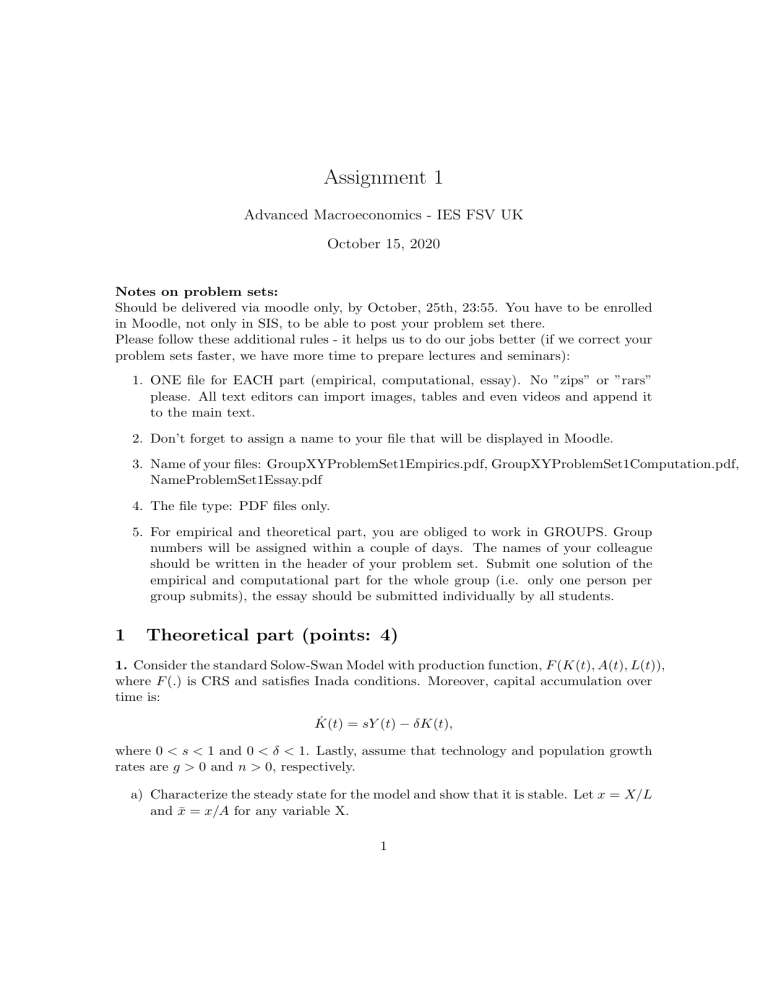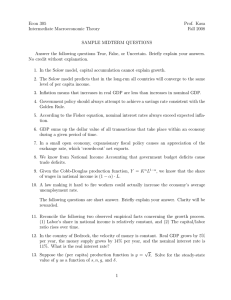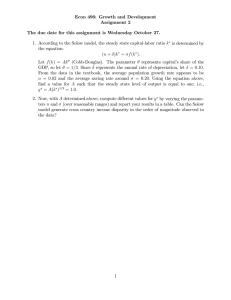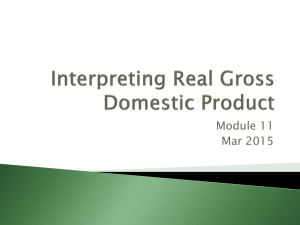
Assignment 1 Advanced Macroeconomics - IES FSV UK October 15, 2020 Notes on problem sets: Should be delivered via moodle only, by October, 25th, 23:55. You have to be enrolled in Moodle, not only in SIS, to be able to post your problem set there. Please follow these additional rules - it helps us to do our jobs better (if we correct your problem sets faster, we have more time to prepare lectures and seminars): 1. ONE file for EACH part (empirical, computational, essay). No ”zips” or ”rars” please. All text editors can import images, tables and even videos and append it to the main text. 2. Don’t forget to assign a name to your file that will be displayed in Moodle. 3. Name of your files: GroupXYProblemSet1Empirics.pdf, GroupXYProblemSet1Computation.pdf, NameProblemSet1Essay.pdf 4. The file type: PDF files only. 5. For empirical and theoretical part, you are obliged to work in GROUPS. Group numbers will be assigned within a couple of days. The names of your colleague should be written in the header of your problem set. Submit one solution of the empirical and computational part for the whole group (i.e. only one person per group submits), the essay should be submitted individually by all students. 1 Theoretical part (points: 4) 1. Consider the standard Solow-Swan Model with production function, F (K(t), A(t), L(t)), where F (.) is CRS and satisfies Inada conditions. Moreover, capital accumulation over time is: K̇(t) = sY (t) − δK(t), where 0 < s < 1 and 0 < δ < 1. Lastly, assume that technology and population growth rates are g > 0 and n > 0, respectively. a) Characterize the steady state for the model and show that it is stable. Let x = X/L and x̄ = x/A for any variable X. 1 b) Suppose the economy is in steady state and the rate of technological progress jumps permanently and immediately to gnew > g ∗ . Characterize the new steady state and the transition dynamics in a Solow diagram. What is the intuition for the behavior of y/A and k/A? c) Show graphically what happens to the growth rates of the capital-labor ratio and per-capita output over time. d) Suppose economy experiences a baby boom in the new steady state leading n to increase. Draw a plot of this change and support it with a phase diagram. 2. Consider the Solow-Swan model with aggregate production function F (Kt , Lt ) = 1 2 Kt3 (At Lt ) 3 . Assume that the economy is on its balanced growth path with the following 1 parameters: depreciation of capital δ = 10 , savings rate s = 15 , population growth 1 1 n = 100 , and technological growth g = 20 . a) Find the steady-state values for output, capital and consumption per unit of effective labor as functions of given parameters. b) Derive the golden rule level of capital and compute the precise level of savings that maximizes consumption in the case of an increase in population resulting in n to 3 increase to 100 . 3. Consider a following version of the Ramsey-Cass-Koopmans (RCK) model in continuous time with zero population growth and no technological progress. Suppose L = 1 so that all variables can be expressed in per-capita variables easily. Furthermore, assume that capital depreciates over time with a rate δ > 0. Households maximize utility given by: u(ct ) = log(ct ), where ct is per-capita consumption. The discount rate is β > 0. The output in per-capita terms is produced using a Cobb-Douglas production function: y = ktα , where kt is capital and 0 < α < 1. Lastly, the income of households includes both wage income (wt ) and after tax interest income from assets ((1 − τ )rt at ), where τ is a fixed tax rate set by the government. a) Show that the chosen utility function satisfies all the standard conditions on utility function. b) Set up a representative household’s optimization problem with budget constraint and no Ponzi game condition. What are the state and control variables? c) Set up the present-value Hamiltonian, derive FOCs and obtain Euler equation. 2 d) Formulate the problem of a representative firm and derive the expressions for interest rate rt and wage wt . e) Combine the first-order conditions for the representative household with those of the representative firm to describe the behavior of consumption and capital over time. 2 Empirical part (points: 4) The accompanying spreadsheet contains original data from Penn World Tables, their description (sheet Legend) and two last sheets with the datasets used for all exercises in this problem set. 2.1 Distribution of GDP per capita across countries (Dataset ps 1 data1) The dataset contains data for the real GDP per capita across countries in several years. Your task is to convert the values to obtain relative values of real GDP per capita to the real GDP per capita of the United States. 1. Show histograms of the real GDP for 1980, 2000 and 2014. 2. Describe, how the distribution of income evolves. Is there any indication of convergence? When does it appear? 3. Are there any interesting shifts of concrete countries? Notes: • Use ratios of GDP relatively to the GDP of the United States. • Choose appropriate number of bars (there shouldn’t be gaps in histogram and also it should be relatively smooth). • If there are any outliers, omit them. Don’t forget to write, if you have some economic intuition for evaluating these countries as outliers. 2.2 Unconditional convergence (Dataset ps 1 data1) Plot scatter plots illustrating potential convergence. 1. Do the scatter plot between growth rate since 1970 to 2014 (growth 70 variable) and the real GDP in 1970. The real GDP in 1970 should be on the horizontal axis and it should be taken in logs. 2. Restrict the dataset to include just the OECD countries and redo the scatter plot. 3. Estimate also linear regressions between growth and initial income for all cases. What the results say about unconditional convergence? Are the conclusions robust on the choice of the sample? Are the OECD countries different? 3 2.3 The Solow model (Dataset ps 1 data2) We’ve estimated parameters of the Solow model based on cross-country regression. Here you have newer data. Try to replicate the estimation from the class, with the growth rates since 1970: log yi = β1 + β2 log si + β3 log(n + g + δ) + ui 1. Discuss the results and comment the difference to the results presented in the lecture. 2. If the specification is correct, then β2 = −β3 must hold. Test this hypothesis and reestimate the original model with this restriction. Hint: Use Wald test (sometimes called Linear restriction test). What can you conclude? 3. Calculate the parameter α of the production function from the restricted model. What is its interpretation? Is the size of α in line with economic intuition? Explain. 2.4 The Solow model (Dataset ps 1 data2) Extend the model for human capital, so that you estimate model: log yi = β1 + β2 log si + β3 log sh + β4 log(n + g + δ) + ui 1. Discuss the results and comment the difference to the results presented in the lecture. 2. Again, impose restriction that β2 + β3 + β4 and = 0 calculate the parameters of production function α and β. 3. Assess, which model (baseline or the model extended for human capital) gives better results and why. Data explanation: • GDP 14: real GDP in 2014 • Popgrow 70 and Popgrow 90: population growth rates, since 1970 to 2014 and since 1990 to 2014 (optional). • Sk 70 and Sk90: average investment ratios, since 1970 to 2014 and since 1990 to 2014 (optional). • Sh 70 and Sh90: average human capital index, since 1970 to 2014 and since 1990 to 2014 (optional). • Gc 70 and gc90: average share of government expenditures on output, just if you want to experiment by yourself with another variable. 4 • Dummies for non-oil producing countries (it’s up to you if you use it or not) and for OECD countries. Notes on estimation: • Use any software you want to conduct the estimations. • When using gretl: just drag and drop the xls file and select the appropriate sheet for analysis. • Gretl logs genr genr commands to generate variables consistent with the Solow model: Gdp 14 Sk 70 Sk 90 Sh 70 Sh 90 gc 70 gc 90 ngd70 = log(Popgrow 70 + 0.05) ngd90 = log(Popgrow 90 + 0.05) • When using R, either copy data into clipboard and paste them in R using , header = TRUE), my pwt data <- read.table(file = "clipboard", sep = "" or use read.xls function. A guideline how to load the Excel data in R can be found for example here: http://www.sthda.com/english/wiki/reading-data-from-excel-files-xls-xlsx-into-r. 3 Essay (points: 4) In this part, you should write a critical summary (around 500 words, 1-2 pages) of the IMF Working Paper ”The missing link between income inequality and economic growth: Inequality of opportunity” (IMF Working Paper WP/19/34). In your summary please explain 1. Main goal of the paper 2. Data and methodology used 3. The most important findings and their POLICY IMPLICATIONS 4. Your CRITIQUE of the paper and its possible issues (methodological, interpretional, etc.) You can find authors’ summary of their paper here https://voxeu.org/article/inequalityopportunity-income-inequality-and-economic-growth You can also refer to additional materials, papers, studies. Look also at data sources and visualisations, such as: https://ourworldindata.org/income-inequality We want to see whether you are able to make critical summary of the debate on a particular economic topic - i.e. understand and explain IN YOUR OWN WORDS what is the main idea, underlying data/theories and comment on their validity. We are not expecting any form of journalism, or free essay on the topic. Therefore, please, avoid things like: 5 • ”borrowing” expressions or full sentences from the article - it is called plagiarism • using pronoun ”we” in summary part - you are speaking ideas of other people • using pronouns ”we” in discussion part - it is your opinion + it should be individual, do not be ashamed of your opinions 6




